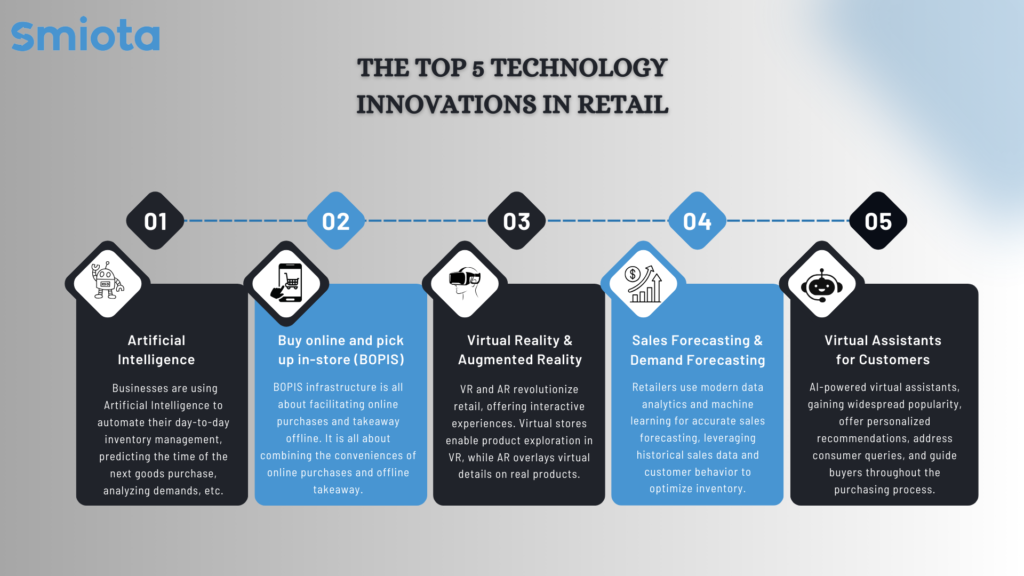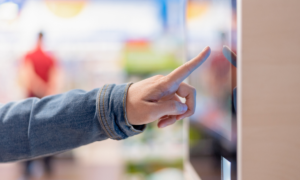Digitization has created a new kind of shopping experience in the world. Consumers are expecting more from retailers in terms of in-store experience. Moreover, rapid technological developments have forced retailers to come up with innovations fast. However, they need to optimize their business operations and hold practical value for the innovations they introduce.
With the rise of e-commerce and online shopping, it has become imperative for retail companies to stay abreast of the latest and the coolest in technology. In this blog post, let us take a look at 5 technology trends that benefit retailers and shoppers equally. We will also learn some of the key customer expectations and challenges retailers face today.
Customer Expectations and Challenges in Retail
More and more retail businesses are finding it difficult to meet the rising expectations of customers. Given that customer satisfaction is one of the key ingredients to achieving long-term success in the highly competitive retail industry, there is no choice for retailers but to use technology to digitally transform shopping experiences. Things like personalized shopping, smooth transition between online & offline experiences, and seamless in-store interactions are not a luxury anymore.
They also expect rewards for loyalty, in-store financing options, and more. Let us dive a little deeper into some of these key customer expectations that are redefining how retailers approach customer service today.
Personalized Shopping Experience
Modern-day customers expect retailers to know them in terms of their demographic characteristics and shopping behaviors, especially when it comes to online shopping. One of the reasons for the success of e-commerce giants like Amazon is its ability to highly personalize shopping interactions. Tailoring in-app search results to shopper needs has also helped Amazon increase overall conversions. It’s a win-win situation with customers getting what they want while the online retailer makes more revenue and profit.
Online and Offline Access
If your retail business has both online and offline stores, it is important to make sure that they are connected. Also, online and offline experiences have to meet the desired quality standards. One cannot fall behind. In addition, your brand must be consistent across all the points of interaction.
Mobile Technology in Retail & Smart Innovations
According to Octal IT Solution, as of January 2022, mobile commerce accounted for nearly two-thirds (65.7 percent) of all global e-commerce retail sales . Having a robust Mobile Point of Sale (POS) system is critical in that context. The app should allow the retailer to easily offer discount coupons and run in-app promotional campaigns.
Rewards for Customer Loyalty
Customer Loyalty programs are key to generating repeat business by consistently engaging your customers. There is a reason why large brands like Starbucks have extensive loyalty programs in place. Starbucks wants its customers to treat it not just as a coffee joint but a wholesome life experience. Loyalty programs can be a great way to build relationships with your customers while encouraging them to buy more.
In-store Financing
Credit systems and payments in installments are not always advisable for your business. However, it can be implemented for a few loyal customers. Partnering with credit card and lending companies is a good idea if in-store financing can increase overall sales.
Innovations in Retail Businesses
The retail industry is in the middle of a technology transformation. Artificial intelligence, data analytics, generative AI, point of sale systems, mobile applications, sales forecasting, and other trends like Buy online and pick-up in-store (BOPIS) are some of the latest innovations in retail.
In this section let us explore the top 5 technology innovations that are ruling the retail industry today:
Artificial Intelligence
AI is the front-runner of all the innovations in retail. Artificial Intelligence has transformed every industry and retail is no exception. New-age retailers are using AI-enabled smart automation to automate their day-to-day inventory management, predicting the time of the next goods purchase, analyzing demands, etc.
Data analysis leveraging artificial intelligence has also been a game-changer by helping keep track of customers’ behaviors. Generative AI has also shown its presence in retail by automating tasks like online marketing, social media promotion, content publishing, advertising, etc.
Buy online and pick up in-store (BOPIS) and smart lockers
BOPIS infrastructure is all about facilitating online purchases with offline takeaway. This retail innovation involves combining the conveniences of online purchases and offline pickup. It also eliminates shipping, packaging, and delivery agents. BOPIS benefits retail shop owners as well as customers by making the best of physical and digital shopping experiences.
One of the key trends that has emerged with respect to BOPIS are smart lockers. Smart lockers are digital locker systems that modernize the traditional lock-and-key system. They use an onboard tablet or mobile app to manage the locker. They can seamlessly integrate with existing backend systems to help manage your inventory and orders. Smart lockers are secure solutions without the need for any staff to facilitate the BOPIS experience.
Virtual Reality & Augmented Reality
Virtual Reality (VR) and Augmented Reality (AR) are transforming the way shoppers are interacting with retail products. VR makes it possible to offer a ‘close to real’ shopping experience completely virtual with the help of devices like VR glasses. On the other hand, AR enables a unique experience by adding virtual information or a ‘virtual world’ on top of a real-life environment. For instance, consumers can use an AR app to visualize how placing furniture would look like in their homes or office buildings.
Sales Forecasting & Demand Forecasting
Using advanced data analytics and machine learning algorithms, retailers are now able to improve their sales forecasting & demand prediction abilities. Predictive analytics turns to historical sales data, customer behavior patterns, and market trends to obtain accurate forecasts. This allows retailers to control inventory, thus preventing looping between overstocks and stockouts to achieve a harmonious supply chain.
The knowledge of customer tastes and demand patterns helps retailers in matching their inventory with market needs so that the right products are accessible at the right time. This is critical in ensuring customer retention and enhancing the overall buying experience.
Virtual Assistants for Customers
Virtual assistants enabled by AI are becoming very popular nowadays. They are capable of making product recommendations, addressing consumer queries, and guiding buyers during the entire purchase journey. Chatbots that are available on websites and mobile apps allow clients to obtain live support, which in turn leads to higher conversions and better sales.
Conclusion
Innovations in retail like BOPIS, artificial intelligence, forecasting, virtual reality, etc., can accelerate business growth for retailers. Among these trends, smart lockers are set to create a wave in the retail industry with their ability to reduce long term operational costs, enhance consumer & staff experience, and even reduce carbon footprint by eliminating activities that contribute to pollution.
Smiota has pioneered in the field of smart lockers and is already working with some of the largest brands in the world including Facebook, Berkshire, and Spotify. Learn more about our smart locker solutions here. For any product queries, please feel free to get in touch with us.





